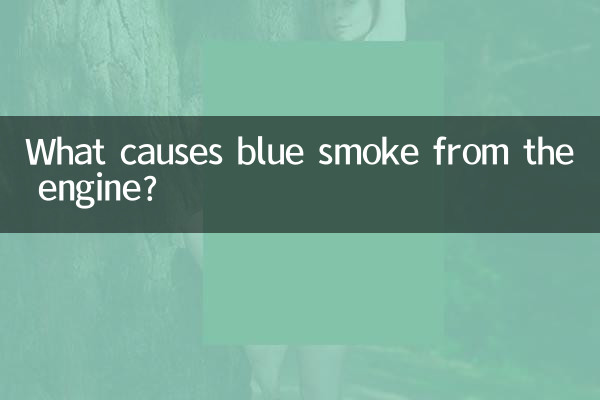What causes blue smoke from the engine?
Blue smoke from the engine is one of the common malfunctions experienced by many car owners and maintenance personnel, and is usually related to engine oil burning. The appearance of blue smoke not only affects vehicle performance, but may also indicate serious engine problems. This article will combine the hot topics and hot content on the Internet in the past 10 days, analyze the main reasons for blue smoke from the engine, and provide structured data for readers' reference.
1. The main reasons for engine blue smoke

Blue smoke from an engine is usually caused by oil entering the combustion chamber and being burned. Here are some common reasons:
| reason | Detailed description |
|---|---|
| Piston rings worn or damaged | Worn piston rings can cause oil to pass from the crankcase into the combustion chamber, causing blue smoke. |
| Valve guide or oil seal aging | Aging valve guides or oil seals can cause oil to seep into the combustion chamber, producing blue smoke. |
| Turbocharger failure | A damaged turbocharger seal can cause oil to leak and enter the exhaust system, producing blue smoke. |
| Too much oil added | Too much oil increases crankcase pressure, causing oil to be forced into the combustion chamber. |
| Serious carbon deposits inside the engine | Carbon deposits can cause piston rings to seize and not seal effectively, allowing oil to enter the combustion chamber. |
2. The dangers of blue smoke from engines
Blue smoke from the engine is not only a malfunction, but may also cause further damage to the vehicle and engine. The following are its main hazards:
| harm | Influence |
|---|---|
| Engine oil consumption too fast | Burning of engine oil will cause the amount of engine oil to decrease rapidly and increase the risk of engine wear. |
| power loss | Too much oil in the combustion chamber will affect the combustion efficiency of fuel, resulting in insufficient power. |
| Emissions exceeding standards | Blue smoke contains incompletely burned engine oil particles, which can cause exhaust emissions to exceed standards. |
| Shortened engine life | Long-term burning of engine oil will lead to increased carbon deposits, further aggravating engine wear. |
3. How to diagnose and solve the problem of blue smoke from the engine
For the problem of blue smoke emitting from the engine, car owners can make a preliminary diagnosis and solve the problem through the following steps:
| step | operate |
|---|---|
| Check engine oil level | Make sure the engine oil level is within the normal range and avoid excess or deficiency. |
| Observe the timing of blue smoke appearance | Blue smoke during cold start may be a valve oil seal problem; blue smoke while driving may be a piston ring or turbocharger problem. |
| Check turbocharger | If the vehicle is equipped with a turbocharger, check that it is properly sealed. |
| Perform cylinder pressure test | Use a cylinder pressure test to determine whether the piston rings are worn or damaged. |
| Replace aging parts | Such as valve oil seals, piston rings or turbocharger seals, etc. |
4. Measures to prevent blue smoke from the engine
To avoid the problem of blue smoke from the engine, car owners can take the following preventive measures:
| measure | illustrate |
|---|---|
| Change engine oil and filter regularly | Use engine oil that meets the standard and replace it according to maintenance intervals. |
| Avoid long-term high-load operation | High load operation will accelerate the wear of engine components. |
| Check your turbocharger regularly | The turbocharger is a wearing part and its working condition needs to be checked regularly. |
| Keep your engine clean | Clean carbon deposits regularly to avoid piston ring sticking. |
5. The hot topics of discussion on the Internet in the past 10 days about blue smoke emitting from engines
According to the hot topics on the Internet in the past 10 days, the problem of blue smoke from the engine is mainly concentrated in the following aspects:
| hot topics | Discussion content |
|---|---|
| Turbocharged models emit blue smoke | Many car owners report that turbocharged models are more prone to blue smoke problems, which may be related to the aging of the turbine seals. |
| Old vehicles emitting blue smoke | Aging of piston rings and valve oil seals in older vehicles is the main cause of blue smoke. |
| The relationship between engine oil brands and blue smoke | Some car owners discuss the impact of different brands of engine oil on blue smoke from the engine. |
| DIY fixes | Some car owners shared their experience of mitigating blue smoke by replacing valve oil seals or adding repair agents. |
Summarize
Blue engine smoke is a cause for concern and is usually related to oil burning. Through the structured analysis of this article, car owners can better understand its causes, hazards and solutions. Regular maintenance and inspection are the key to preventing blue smoke. If the problem is serious, it is recommended to send it for repair in time to avoid greater losses.

check the details

check the details